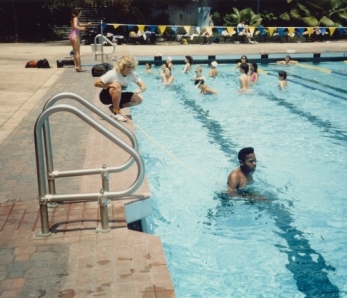Featured Exercise: Sprinting on Tether
This was the technique that helped countless sprinters, jumpers, hurdlers, and middle distance runners in the 1980s and 1990s. As Lynda pioneered the use of water rehab for athletes, those were the Olympians who proved its worth.

If the coach had planned a workout for a sprinter or jumper that was ten short sprints, that’s what we would do in the water. If an 800M runner needed to do three x 400M and three x 300M, we would run for 60 seconds for the 400M and 45 seconds for the 300M. To help them do the mental work associated with those distances, we would visualize where they were on the track – the turns and the straightaways. They did so well with this combined physical and mental training that they often came out of the pool much faster than expected since they had been away from the track for a week to a month. The conclusion we reached was that the resistance of the water made their arms so strong that they were able to drive their running machine with more power.
They did so well that word got out fast. Then came the basketball, volleyball, tennis, and ice hockey players. They all realized the immense benefits of retaining their timing and strength in the water when they couldn’t do their normal workouts on land. Today many of those athletes use this same technique as they coach their own athletes in colleges and athletic clubs around the country.
100% secure and private. You can unsubscribe at any time